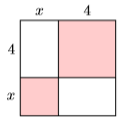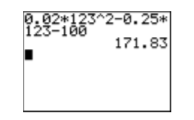5.4: Adding and Subtracting Polynomials
- Page ID
- 19880
\( \newcommand{\vecs}[1]{\overset { \scriptstyle \rightharpoonup} {\mathbf{#1}} } \)
\( \newcommand{\vecd}[1]{\overset{-\!-\!\rightharpoonup}{\vphantom{a}\smash {#1}}} \)
\( \newcommand{\dsum}{\displaystyle\sum\limits} \)
\( \newcommand{\dint}{\displaystyle\int\limits} \)
\( \newcommand{\dlim}{\displaystyle\lim\limits} \)
\( \newcommand{\id}{\mathrm{id}}\) \( \newcommand{\Span}{\mathrm{span}}\)
( \newcommand{\kernel}{\mathrm{null}\,}\) \( \newcommand{\range}{\mathrm{range}\,}\)
\( \newcommand{\RealPart}{\mathrm{Re}}\) \( \newcommand{\ImaginaryPart}{\mathrm{Im}}\)
\( \newcommand{\Argument}{\mathrm{Arg}}\) \( \newcommand{\norm}[1]{\| #1 \|}\)
\( \newcommand{\inner}[2]{\langle #1, #2 \rangle}\)
\( \newcommand{\Span}{\mathrm{span}}\)
\( \newcommand{\id}{\mathrm{id}}\)
\( \newcommand{\Span}{\mathrm{span}}\)
\( \newcommand{\kernel}{\mathrm{null}\,}\)
\( \newcommand{\range}{\mathrm{range}\,}\)
\( \newcommand{\RealPart}{\mathrm{Re}}\)
\( \newcommand{\ImaginaryPart}{\mathrm{Im}}\)
\( \newcommand{\Argument}{\mathrm{Arg}}\)
\( \newcommand{\norm}[1]{\| #1 \|}\)
\( \newcommand{\inner}[2]{\langle #1, #2 \rangle}\)
\( \newcommand{\Span}{\mathrm{span}}\) \( \newcommand{\AA}{\unicode[.8,0]{x212B}}\)
\( \newcommand{\vectorA}[1]{\vec{#1}} % arrow\)
\( \newcommand{\vectorAt}[1]{\vec{\text{#1}}} % arrow\)
\( \newcommand{\vectorB}[1]{\overset { \scriptstyle \rightharpoonup} {\mathbf{#1}} } \)
\( \newcommand{\vectorC}[1]{\textbf{#1}} \)
\( \newcommand{\vectorD}[1]{\overrightarrow{#1}} \)
\( \newcommand{\vectorDt}[1]{\overrightarrow{\text{#1}}} \)
\( \newcommand{\vectE}[1]{\overset{-\!-\!\rightharpoonup}{\vphantom{a}\smash{\mathbf {#1}}}} \)
\( \newcommand{\vecs}[1]{\overset { \scriptstyle \rightharpoonup} {\mathbf{#1}} } \)
\( \newcommand{\vecd}[1]{\overset{-\!-\!\rightharpoonup}{\vphantom{a}\smash {#1}}} \)
\(\newcommand{\avec}{\mathbf a}\) \(\newcommand{\bvec}{\mathbf b}\) \(\newcommand{\cvec}{\mathbf c}\) \(\newcommand{\dvec}{\mathbf d}\) \(\newcommand{\dtil}{\widetilde{\mathbf d}}\) \(\newcommand{\evec}{\mathbf e}\) \(\newcommand{\fvec}{\mathbf f}\) \(\newcommand{\nvec}{\mathbf n}\) \(\newcommand{\pvec}{\mathbf p}\) \(\newcommand{\qvec}{\mathbf q}\) \(\newcommand{\svec}{\mathbf s}\) \(\newcommand{\tvec}{\mathbf t}\) \(\newcommand{\uvec}{\mathbf u}\) \(\newcommand{\vvec}{\mathbf v}\) \(\newcommand{\wvec}{\mathbf w}\) \(\newcommand{\xvec}{\mathbf x}\) \(\newcommand{\yvec}{\mathbf y}\) \(\newcommand{\zvec}{\mathbf z}\) \(\newcommand{\rvec}{\mathbf r}\) \(\newcommand{\mvec}{\mathbf m}\) \(\newcommand{\zerovec}{\mathbf 0}\) \(\newcommand{\onevec}{\mathbf 1}\) \(\newcommand{\real}{\mathbb R}\) \(\newcommand{\twovec}[2]{\left[\begin{array}{r}#1 \\ #2 \end{array}\right]}\) \(\newcommand{\ctwovec}[2]{\left[\begin{array}{c}#1 \\ #2 \end{array}\right]}\) \(\newcommand{\threevec}[3]{\left[\begin{array}{r}#1 \\ #2 \\ #3 \end{array}\right]}\) \(\newcommand{\cthreevec}[3]{\left[\begin{array}{c}#1 \\ #2 \\ #3 \end{array}\right]}\) \(\newcommand{\fourvec}[4]{\left[\begin{array}{r}#1 \\ #2 \\ #3 \\ #4 \end{array}\right]}\) \(\newcommand{\cfourvec}[4]{\left[\begin{array}{c}#1 \\ #2 \\ #3 \\ #4 \end{array}\right]}\) \(\newcommand{\fivevec}[5]{\left[\begin{array}{r}#1 \\ #2 \\ #3 \\ #4 \\ #5 \\ \end{array}\right]}\) \(\newcommand{\cfivevec}[5]{\left[\begin{array}{c}#1 \\ #2 \\ #3 \\ #4 \\ #5 \\ \end{array}\right]}\) \(\newcommand{\mattwo}[4]{\left[\begin{array}{rr}#1 \amp #2 \\ #3 \amp #4 \\ \end{array}\right]}\) \(\newcommand{\laspan}[1]{\text{Span}\{#1\}}\) \(\newcommand{\bcal}{\cal B}\) \(\newcommand{\ccal}{\cal C}\) \(\newcommand{\scal}{\cal S}\) \(\newcommand{\wcal}{\cal W}\) \(\newcommand{\ecal}{\cal E}\) \(\newcommand{\coords}[2]{\left\{#1\right\}_{#2}}\) \(\newcommand{\gray}[1]{\color{gray}{#1}}\) \(\newcommand{\lgray}[1]{\color{lightgray}{#1}}\) \(\newcommand{\rank}{\operatorname{rank}}\) \(\newcommand{\row}{\text{Row}}\) \(\newcommand{\col}{\text{Col}}\) \(\renewcommand{\row}{\text{Row}}\) \(\newcommand{\nul}{\text{Nul}}\) \(\newcommand{\var}{\text{Var}}\) \(\newcommand{\corr}{\text{corr}}\) \(\newcommand{\len}[1]{\left|#1\right|}\) \(\newcommand{\bbar}{\overline{\bvec}}\) \(\newcommand{\bhat}{\widehat{\bvec}}\) \(\newcommand{\bperp}{\bvec^\perp}\) \(\newcommand{\xhat}{\widehat{\xvec}}\) \(\newcommand{\vhat}{\widehat{\vvec}}\) \(\newcommand{\uhat}{\widehat{\uvec}}\) \(\newcommand{\what}{\widehat{\wvec}}\) \(\newcommand{\Sighat}{\widehat{\Sigma}}\) \(\newcommand{\lt}{<}\) \(\newcommand{\gt}{>}\) \(\newcommand{\amp}{&}\) \(\definecolor{fillinmathshade}{gray}{0.9}\)In this section we concentrate on adding and subtracting polynomial expressions, based on earlier work combining like terms in Ascending and Descending Powers. Let’s begin with an addition example.
Example \(\PageIndex{1}\)
Simplify: \[\left(a^{2}+3 a b-b^{2}\right)+\left(4 a^{2}+11 a b-9 b^{2}\right) \nonumber \]
Solution
Use the commutative and associative properties to change the order and regroup. Then combine like terms.
\[\begin{aligned}\left(a^{2}+3 a b-b^{2}\right) &+\left(4 a^{2}+11 a b-9 b^{2}\right) \\ &=\left(a^{2}+4 a^{2}\right)+(3 a b+11 a b)+\left(-b^{2}-9 b^{2}\right) \\ &=5 a^{2}+14 a b-10 b^{2} \end{aligned} \nonumber \]
Exercise \(\PageIndex{1}\)
Simplify: \(\left(3 s^{2}-2 s t+4 t^{2}\right)+\left(s^{2}+7 s t-5 t^{2}\right)\)
- Answer
-
\(4 s^{2}+5 s t-t^{2}\)
Let’s combine some polynomial functions.
Example \(\PageIndex{2}\)
Given \(f(x)=3x^2−4x−8\) and \(g(x)=x^2−11x+15\), simplify \(f(x)+g(x)\).
Solution
First, replace \(f(x)\) and \(g(x)\) with their definitions. Be sure to surround each polynomial with parentheses, because we are asked to add all of \(f(x)\) to all of \(g(x)\).
\[f(x)+g(x) = (3x^2 −4x−8) + (x^2 −11x + 15) \nonumber \] Now use the commutative and associative properties to change the order and regroup. Combine like terms.
\[\begin{array}{l}{=\left(3 x^{2}+x^{2}\right)+(-4 x-11 x)+(-8+15)} \\ {=4 x^{2}-15 x+7}\end{array} \nonumber \]
Hence, \(f(x)+g(x)=4x^2 −15x + 7\).
Exercise \(\PageIndex{2}\)
Given \(f(x)=2x^2 +9x−5\) and \(g(x)=−x^2 −4x + 3\), simplify \(f(x)+g(x)\).
- Answer
-
\(x^{2}+5 x-2\)
If you are comfortable skipping a step or two, it is not necessary to write down all of the steps shown in Examples \(\PageIndex{1}\) and \(\PageIndex{2}\). Let’s try combining like terms mentally in the next example.
Example \(\PageIndex{3}\)
Simplify: \[\left(x^{3}-2 x^{2} y+3 x y^{2}+y^{3}\right)+\left(2 x^{3}-4 x^{2} y-8 x y^{2}+5 y^{3}\right) \nonumber \]
Solution
If we use the associative and commutative property to reorder and regroup, then combine like terms, we get the following result.
\[\begin{aligned}\left(x^{3}-2 x^{2} y\right.&+3 x y^{2}+y^{3} )+\left(2 x^{3}-4 x^{2} y-8 x y^{2}+5 y^{3}\right) \\ &=\left(x^{3}+2 x^{3}\right)+\left(-2 x^{2} y-4 x^{2} y\right)+\left(3 x y^{2}-8 x y^{2}\right)+\left(y^{3}+5 y^{3}\right) \\ &=3 x^{3}-6 x^{2} y-5 x y^{2}+6 y^{3} \end{aligned} \nonumber \]
However, if we can combine like terms mentally, eliminating the middle step, it is much more efficient to write:
\[\begin{array}{l}{\left(x^{3}-2 x^{2} y+3 x y^{2}+y^{3}\right)+\left(2 x^{3}-4 x^{2} y-8 x y^{2}+5 y^{3}\right)} \\ {\quad \quad=3 x^{3}-6 x^{2} y-5 x y^{2}+6 y^{3}}\end{array} \nonumber \]
Exercise \(\PageIndex{3}\)
Simplify: \(\left(-5 a^{2} b+4 a b-3 a b^{2}\right)+\left(2 a^{2} b+7 a b-a b^{2}\right)\)
- Answer
-
\(-3 a^{2} b+11 a b-4 a b^{2} d\)
Negating a Polynomial
Before attempting subtraction of polynomials, let’s first address how to negate or “take the opposite” of a polynomial. First recall that negating is equivalent to multiplying by \(−1\).
Negating
If \(a\) is any number, then
\[−a =(−1)a. \nonumber \]
That is, negating is equivalent to multiplying by \(−1\).
We can use this property to simplify \(−(a + b)\). First, negating is identical to multiplying by \(−1\). Then we can distribute the \(−1\).
\[\begin{aligned} -(a+b) &= (-1)(a+b) \quad \color {Red} \text { Negating is equivalent to multiplying by } -1 \\ &= (-1) a+(-1) b \quad \color {Red} \text { Distribute the }-1 . \\ &= -a+(-b) \quad \color {Red} \text { Simplify: }(-1) a=-a \text { and }(-1) b=-b \\ &= -a-b \quad \color {Red} \text { Subtraction means add the opposite. } \end{aligned} \nonumber \]
Thus, \(−(a + b)=−a −b\). However, it is probably simpler to note that the minus sign in front of the parentheses simply changed the sign of each term inside the parentheses.
Negating a sum
When negating a sum of terms, the effect of the minus sign is to change each term in the parentheses to the opposite sign. \[−(a + b)=−a−b \nonumber \]
Let’s look at this principle in the next example.
Example \(\PageIndex{4}\)
Simplify: \(-\left(-3 x^{2}+4 x-8\right)\)
Solution
First, negating is equivalent to multiplying by \(−1\). Then distribute the \(−1\).
\[\begin{aligned} -&\left(-3 x^{2}+4 x-8\right) \\ &=(-1)\left(-3 x^{2}+4 x-8\right) \quad \color {Red} \text{Negating is equivalent to multiplying by } -1\\ &=(-1)\left(-3 x^{2}\right)+(-1)(4 x)-(-1)(8) \quad \color {Red} \text {Distribute the } -1 \\ &=3 x^{2}+(-4 x)-(-8) \quad \color {Red} \text {Simplify: } (-1)(-3 x^{2})=3 x^{2}, (-1)(4 x)=-4 x, \text {and} (-1)(8)=-8\\ &=3 x^{2}-4 x+8 \quad \color {Red} \text {Subtraction means add the opposite.} \end{aligned} \nonumber \]
Alternate solution:
As we saw above, a negative sign in front of a parentheses simply changes the sign of each term inside the parentheses. So it is much more efficient to write\[−(−3x^2 +4x−8) = 3x^2 −4x +8 \nonumber \]simply changing the sign of each term inside the parentheses.
Exercise \(\PageIndex{4}\)
Simplify: \(-\left(2 x^{2}-3 x+9\right)\)
- Answer
-
\(-2 x^{2}+3 x-9\)
Subtracting Polynomials
Now that we know how to negate a polynomial (change the sign of each term of the polynomial), we’re ready to subtract polynomials.
Example \(\PageIndex{5}\)
Simplify: \(\left(y^{3}-3 y^{2} z+4 y z^{2}+z^{3}\right)-\left(2 y^{3}-8 y^{2} z+2 y z^{2}-8 z^{3}\right)\)
Solution
First, distribute the minus sign, changing the sign of each term of the second polynomial.
\[\left(y^{3}-3 y^{2} z+4 y z^{2}+z^{3}\right)-\left(2 y^{3}-8 y^{2} z+2 y z^{2}-8 z^{3}\right)=y^{3}-3 y^{2} z+4 y z^{2}+z^{3}-2 y^{3}+8 y^{2} z-2 y z^{2}+8 z^{3} \nonumber \]
Regroup, combining like terms. You may perform this next step mentally if you wish.
\[\begin{array}{l}{=\left(y^{3}-2 y^{3}\right)+\left(-3 y^{2} z+8 y^{2} z\right)+\left(4 y z^{2}-2 y z^{2}\right)+\left(z^{3}+8 z^{3}\right)} \\ {=-y^{3}+5 y^{2} z+2 y z^{2}+9 z^{3}}\end{array} \nonumber \]
Exercise \(\PageIndex{5}\)
Simplify: \(\left(4 a^{2} b+2 a b-7 a b^{2}\right)-\left(2 a^{2} b-a b-5 a b^{2}\right)\)
- Answer
-
\(2 a^{2} b+3 a b-2 a b^{2}\)
Let’s subtract two polynomial functions.
Example \(\PageIndex{6}\)
Given \(p(x)=−5x^3 +6 x − 9\) and \(q(x)=6 x^2 − 7x − 11\), simplify \(p(x)−q(x)\).
Solution
First, replace \(p(x)\) and \(q(x)\) with their definitions. Because we are asked to subtract all of \(q(x)\) from all of \(p(x)\), it is critical to surround each polynomial with parentheses.
\[p(x)-q(x)=\left(-5 x^{3}+6 x-9\right)-\left(6 x^{2}-7 x-11\right) \nonumber \]
Distribute the minus sign, changing the sign of each term in the second polynomial, then regroup and combine like terms.
\[\begin{array}{l}{=-5 x^{3}+6 x-9-6 x^{2}+7 x+11} \\ {\color {Red} =-5 x^{3}-6 x^{2}+(6 x+7 x)+(-9+11)} \\ {=-5 x^{3}-6 x^{2}+13 x+2}\end{array} \nonumber \]
However, after distributing the minus sign, if we can combine like terms mentally, eliminating the middle step, it is much more efficient to write:
\[\begin{aligned} p(x)-q(x) &=\left(-5 x^{3}+6 x-9\right)-\left(6 x^{2}-7 x-11\right) \\ &=-5 x^{3}+6 x-9-6 x^{2}+7 x+11 \\ &=-5 x^{3}-6 x^{2}+13 x+2 \end{aligned} \nonumber \]
Exercise \(\PageIndex{6}\)
Given \(f(x)=3x^2 +9x−4\) and \(g(x)=−5x2 +4x−6\), simplify \(f(x)−g(x)\).
- Answer
-
\(8 x^{2}+5 x+2\)
Some Applications
Recall that the area of a rectangle having length \(L\) and width \(W\) is found using the formula \(A = LW\). The area of a square having side s is found using the formula \(A = s^2\) (see Figure \(\PageIndex{1}\)).

Example \(\PageIndex{7}\)
Find the area of the square in Figure \(\PageIndex{2}\) by summing the area of its parts.

Solution
Let’s separate each of the four pieces and label each with its area (see Figure \(\PageIndex{3}\)).

The two shaded squares in Figure \(\PageIndex{3}\) have areas \(A_1 = x^2\) and \(A_3 = 9\), respectively. The two unshaded rectangles in Figure \(\PageIndex{3}\) have areas \(A_2 =3 x\) and \(A_4 =3x\). Summing these four areas gives us the area of the entire figure.
\[\begin{aligned} A &=A_{1}+A_{2}+A_{3}+A_{4} \\ &=x^{2}+3 x+9+3 x \\ &=x^{2}+6 x+9 \end{aligned} \nonumber \]
Exercise \(\PageIndex{7}\)
Find the area of the square shown below by summing the area of its parts.

- Answer
-
\(x^{2}+8 x+16\)
Example \(\PageIndex{8}\)
Ginger runs a business selling wicker baskets. Her business costs for producing and selling \(x\) wicker baskets are given by the polynomial function \(C(x)=100+3x−0.02x^2\). The revenue she earns from selling \(x\) wicker baskets is given by the polynomial function \(R(x)=2.75x\). Find a formula for \(P(x)\), the profit made from selling \(x\) wicker baskets. Use your formula to determine Ginger’s profit if she sells \(123\) wicker baskets.
Solution
The profit made from selling \(x\) wicker baskets is found by subtracting the costs incurred from the revenue received. In symbols: \[P(x)=R(x)−C(x) \nonumber \]
Next, replace \(R(x)\) and \(C(x)\) with their definitions. Because we are supposed to subtract all of the cost from the revenue, be sure to surround the cost polynomial with parentheses.\[P(x)=2 .75x−(100 + 3x−0.02x^2) \nonumber \]
Distribute the minus sign and combine like terms.
\[\begin{array}{l}{=2.75 x-100-3 x+0.02 x^{2}} \\ {=0.02 x^{2}-0.25 x-100}\end{array} \nonumber \]
Thus, the profit function is \(P(x)=0 .02x^2 −0.25x−100\).
Next, to determine the profit if \(123\) wicker baskets are sold, substitute \(123\) for \(x\) in the profit function \(P(x)\).
\[\begin{aligned} P(x) &=0.02 x^{2}-0.25 x-100 \\ P(123) &=0.02(123)^{2}-0.25(123)-100 \end{aligned} \nonumber \]
You can now use your graphing calculator to determine the profit (see Figure \(\PageIndex{5}\)). Hence, the profit made from selling \(123\) wicker baskets is \(\$171.83\).

Exercise \(\PageIndex{8}\)
The costs for producing and selling \(x\) widgets are given by the polynomial function \(C(x) = 50 + 5x−0.5x^2\), and the revenue for selling \(x\) widgets is given by the polynomial function \(R(x)=3.5x\). Determine the profit if \(75\) widgets are sold.
- Answer
-
\(\$ 2,650\)


